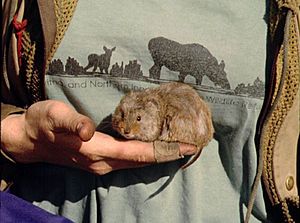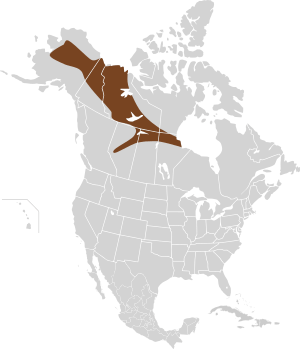Taiga vole facts for kids
Quick facts for kids Taiga vole |
|
|---|---|
 |
|
| Conservation status | |
| Scientific classification | |
| Genus: |
Microtus
|
| Species: |
xanthognathus
|
 |
|
The taiga vole (Microtus xanthognathus) is a large vole that lives in northwestern North America. You can find it in places like Alaska and northwestern Canada. Its name, "taiga vole," comes from the boreal taiga zone where it lives.
People also call it the yellow-cheeked vole' or chestnut-cheeked vole. This is because of the rusty-yellow color on its face, especially around its whiskers. The scientific name also tells us about this feature: "xantho" is Greek for yellow, and "gnathus" is Greek for jaw. This vole is usually much bigger than most other voles in North America, especially those in the Microtus group.
An adult taiga vole is typically about 186–226 mm (7.3–8.9 in) long, not counting its tail. It usually weighs between 140–170 g (4.9–6.0 oz).
These voles live in northern forests, often close to water or bogs. They create paths, called runways, through the plants on the ground and dig burrows underground. They usually live together in groups called colonies.
Contents
What Taiga Voles Eat
Taiga voles eat different kinds of plants. Their diet includes grasses, lichens, horsetails, and berries. They are smart and store food in their burrows to eat during the winter months.
Communication and Activity
Just like the singing vole, taiga voles might make a special warning call. This call helps to tell other voles in their colony if there is danger nearby. They are active all year round, even in winter. They usually move around during darker times of the day. While you might not see them often, they can be found in large numbers in certain areas.
Where Taiga Voles Live
The taiga vole's home stretches from northwestern Canada all the way to Alaska. Scientists have found old taiga vole fossils much farther south. These fossils were found in places like Arkansas, Tennessee, and Virginia. This suggests that taiga voles used to live in a much larger area than they do today.
Fossils have been found south of where a huge ice sheet, called the Laurentide Ice Sheet, once was. This was during the late Pleistocene period. The fossil evidence suggests that these voles moved northwest after a big ice age event called the Wisconsin glaciation. Today, taiga voles mainly live in boreal forests and tundra. These are the types of habitats they prefer. Scientists believe that during the ice age, parts of the southern United States had these same types of forests and tundra. This explains why their fossils are found so far south.
Reproduction and Life Cycle
Taiga voles have a mating system where one male mates with several females. Males are very protective of their territory and food. They usually mate during the North American summer, from early May to around September. Each female typically has two litters of young per season. The second litter is usually smaller than the first. A female taiga vole can have 7 to 10 young in one litter. The number of voles in an area can change a lot from year to year.
During winter, taiga voles share nests in groups. A small group, usually 5 to 10 voles, will live together in one nest. They build very long burrows. Sometimes, these burrows even go into the water, allowing them to swim out. Voles living in crowded areas tend to be heavier than those in less crowded places. They also use alarm calls, especially during mating season, to warn others of danger.
Taiga voles need to eat often. They cannot go more than 24 hours without food, or they could starve. They don't have a special way to slow down their body's energy use like some other small rodents do. To save energy, they can lower their body temperature slightly, by about half a degree Celsius.
See also

- In Spanish: Microtus xanthognathus para niños


